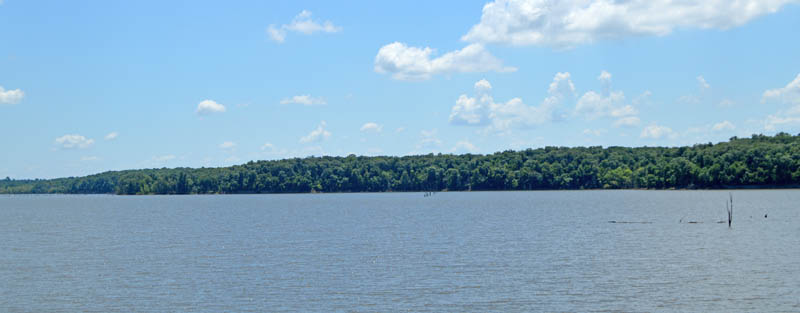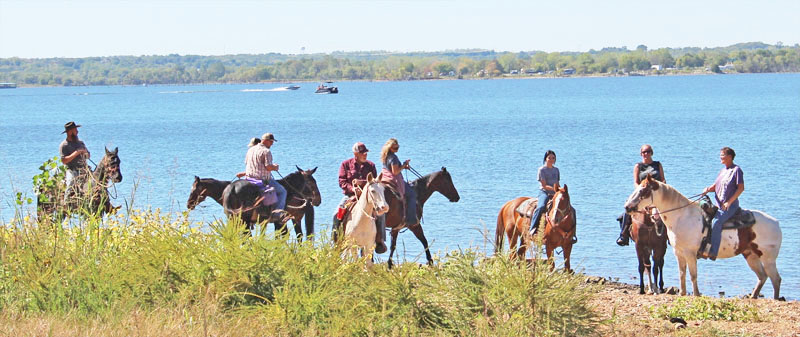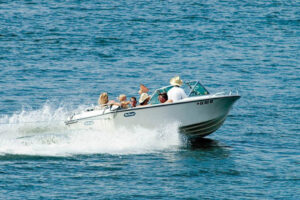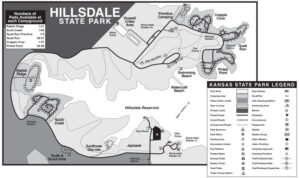Hillsdale Lake is a reservoir located in the northwestern part of Miami County, in northeast Kansas. One of Kansas’ newest reservoirs, it welcomes visitors to its more than 12,000 acres of park and wildlife area. The surface area of the lake is approximately 4,580 acres, and its maximum depth is approximately 57 feet.
In the 1940s, area landowners began lobbying for a comprehensive flood control plan on the Marais des Cygnes, Osage River, and the Missouri River. In 1954, the United States Congress authorized the Hillsdale Lake Project because of the strong support of local citizens and the Hillsdale Lake Development Association. Through their work, the lake became a reality. In 1973, construction funds were allocated, and land acquisition began. The U.S. Army Corps of Engineers began construction in 1978. Hillsdale Dam, which impounds Big Bull Creek to create a V-shaped reservoir, was completed in 1982. More than 70% of the standing timber was left in the reservoir basin to provide a habitat for fish. The earthen dam generates no hydroelectric power.
Hillsdale State Park officially opened in 1994.
Hillsdale Lake controls a watershed that covers approximately 144 square miles. The 92,000-acre watershed is divided among four counties, including 42% in Miami County, 46% in Johnson County, 5% in Douglas County, and 2% in Franklin County.
Many individuals in the surrounding area rely on Hillsdale Lake as their primary source of drinking water. More than 30,000 residents of southern Johnson County and northern Miami County use it for this purpose. As a water supply source, the lake can provide 17.3 million gallons of water daily to meet the municipal and industrial needs of surrounding communities. Spring Hill and Gardner also utilize water from Hillsdale Lake.
Among the activities at Hillsdale are camping, fishing, swimming, boating, hunting, and hiking. The Saddle Ridge equestrian area on the east side of the reservoir has about 32 miles of marked trails available to horseback riders.
Approximately 4,500 acres of water and 51 miles of shoreline are open to fishing, except for developed beach areas and boat ramps. Walleye, catfish, largemouth bass, crappie, and bluegill are abundant.
Approximately 7,000 acres within the wildlife area and state park at Hillsdale are open to hunting. Waterfowl, big and small game, and upland gamebird hunting are allowed in state parks and wildlife areas during the designated hunting seasons. Developed areas, such as boat ramps, shelter areas, parking lots, beaches, campgrounds, and the dam, are designated safety zones where hunting is prohibited.
Two developed beach areas are open from sunrise to sunset. The one-bathroom and one-bathroom/shower houses are open from May 15 to October 15, from sunrise to sunset. To ensure public safety, the following items and activities are prohibited within the developed beach areas: glass containers, open fires, pets, fishing, boats, and the consumption of alcohol/beer.
Camping is only allowed in the 200 designated camping sites in the Russell Crites Area. Approximately 157 sites offer electric and water hook-ups, with a nightly utility fee required. Three bathroom/shower houses are available during the regular camping season, from April 15 to October 15.
Model airplane flying is allowed in the flying area located south of the dam.
Birdwatchers will see bald eagles, shorebirds, finches, warblers, sparrows, and hawks.
The largest lake in Miami County, Kansas, Hillsdale Lake is conveniently located south of the Kansas City Metro Area between Spring Hill and Paola. It is located at 26001 W. 255th Street near Hillsdale, Kansas, approximately three miles east of the US-169/K-7 and 255th Street interchange. It is approximately 30 miles from Kansas City.
©Kathy Alexander/Legends of Kansas, September 2025.
Also See:
Sources:
Hillsdale State Park
Kansas Department of Wildlife & Parks
Web Archive
Wikipedia




